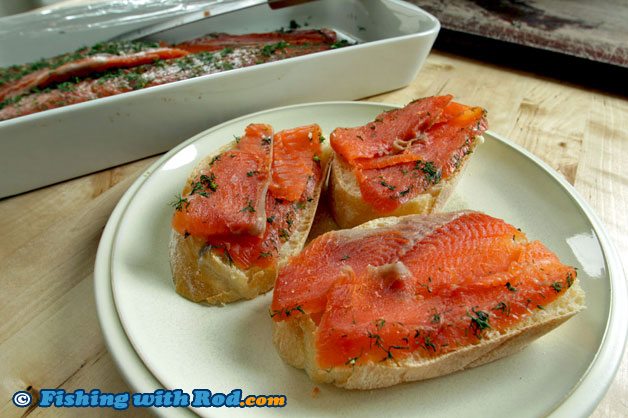Gravlax
By Rodney Hsu, Fishing with Rod | Published in February 2013

Over the past ten years, I have visited Denmark every winter to celebrate Christmas with the in-laws. The festive holiday is always decorated with a variety of local seafood dishes. One particular appetizer, called Gravlax, is among my favourites. Gravlax is simply cured salmon, usually served with salad, or on a thinly sliced bread with dill and mustard. It is also just as good when eaten alone if you have the cravings like I sometimes do late at night.
In Scandinavia, the fish used to prepare Gravlax is Atlantic salmon. It is expensive, therefore Gravlax is only served during special occasions such as Christmas. Because Pacific salmon are readily available for anyone who fishes in British Columbia, I've always wanted to know if Gravlax can be prepared with my own catches. After some research, it turns out the preparation of this delicious treat is incredibly simple!
Ingredients
There are only four ingredients required to make Gravlax. You need fresh salmon of course. The preferred species are sockeye salmon, coho salmon and steelhead. Your fish need to be filleted, skinned and deboned. These fillets need to be frozen so all parasitic nematodes called Anisakis, also commonly known as sushi worm, are killed. Ingestion of fish with these nematodes can have serious consequences such as Anisakiasis, which is a rather painful infection of your gastrointestinal tract. To prevent this, your fish must be frozen overnight at -35℃ or below, or for a week at -20℃ or below.
The other ingredients are coarse salt, brown sugar and fresh dill.
Preparation
Several simple steps are involved when making Gravlax.
- Mix a cup of coarse salt and a cup of brown sugar in a bowl. Add more if needed by following this ratio.
- Finely chop up fresh dill.
- Place a fillet on a deep tray. A deep tray is needed to collect liquid during the curing process.
- Spread the salt/sugar mix onto the fillet so it is completely covered.
- Spread chopped dill onto the fillet.
- Cover it with Saran wrap and place an object on top to press the fillet down.
Once this is done, the tray goes into the fridge. Check it every 12 hours to drain excess liquid. The duration of the cure varies and really depends on your preference. If you prefer your fillet to have more moisture, then a day of curing is adequate. If you prefer your fillet to be saltier and drier, then you should cure it for up to three to five days.
When curing completes, remove the fillet from the tray. I like to wash off all the salt and sugar remaining on the fish. Once it is washed, I like to sprinkle more dill back on the fillet. To serve, thinly slice across the fillet diagonally.
Additional Notes
I use coho salmon which are vacuumed packed and frozen for several months after being caught in September and October. The result has been excellent. I have also been told that steelhead make excellent Gravlax.
If you find the above recipe to be too salty, then please feel free to change the ratio of salt and sugar used for the curing mix. Add less salt and more sugar for a sweeter taste. Other seasonings can also be added to create different tastes. Some recipes suggest adding freshly ground pepper.
Give it a go if you have grown tired of eating grilled or pan fried salmon!

